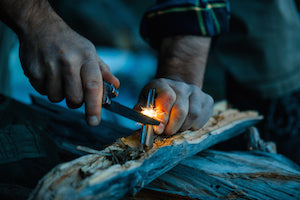
It’s impossible to imagine a world without these monumental places, but it’s vital to be aware they can be extremely dangerous places - especially if you’re unprepared. Our National Parks are some of the best in the world and offer facilities with minimal impact to the surrounding area. We want to make sure you love your experience as much as we do so we put our heads together and created our top 10 list of park essentials you should always have.
Water
Our park systems do an incredible job providing clean water for visitors, but we always bring water - no matter what season. You can only survive a couple days, or less without it, depending on the circumstances. Water has more uses than hydration, it can cool you or your vehicle down when overheating, it can wash dirt, and rinse cuts. So, whether you're planning an extensive hike through Death Valley, or a scenic drive up a mountain, always bring water!

Food
Snacks will keep you going and give you the added energy you’ll need. It’s important to bring something that maximizes your nutrition. Dried fruits or trail mix are much better for the size than a bag of Doritos and a Coke for instance. When you’re planning your hike make sure you have a couple rest points in mind. It’s important to rest, rehydrate, and refuel regularly, so try to keep the breaks short and regular throughout the day.
First Aid Kit
Items like bandages, wraps, tape, and gauze can be easily packed and don’t take a lot of space. If you’re planning a more remote or extensive excursion, you should also include antiseptics, hydration tablets, and some basic medications. It’s important to be aware of plants and animals in the park area so you can make sure to include the appropriate medications in your kit. Whenever you’re planning a trip outdoors you need to be prepared for anything.

Physical Map
US National Parks are relatively well maintained, and the workers and volunteers do an amazing job with monitoring their massive area. Most parks only have Wi-Fi available around the common areas like the visitor center and sometimes campsites. So, it’s always recommended to have a hard copy and downloaded map of the park with you. It’s not uncommon to get lost, but with a map you can orientate yourself and get back on track faster and safer.
Compass
We recommend spending a few dollars for a compass to go with your printed map, so you can spend more time enjoying the trail than looking for it. Even though phones can find your location, without a GPS signal, you’ll likely have to MacGyver a compass in the wilderness or trust your survival training. The difference lies in your phone’s ability to accurately track the magnetic poles without signal. There’s a reason most experienced hikers have a compass.

Towel
Wet and cold is one of the most dangerous circumstances to be in anywhere. Beyond the obvious, towels can have numerous uses, including shade, assisting with climbing, or collecting and carrying things. They can be easily tucked away in your trunk until you need them. Having a towel in your bag is never a bad option, even if it’s just to insulate your bag from the weather.
Jacket
You should always check the weather before planning a trip outdoors, easy enough - but always take it with a grain of salt. If the lows are in the upper 60s or 70s you don’t need a big winter jacket. They can be used for warmth, protecting you from the elements, and can add a protective layer hiking through overgrown areas. A nice rain jacket can come in handy rain or shine.

Backpack
You want a durable backpack that can stand up to the wear and tear of the outdoors. Nearly every bag with zippers is “water resistant”, meaning you’ll still want a sealable plastic bag for any electronics you’re bringing. They’re generally ok with light rain and snow, and you can find them for a fair price. You’ll really only need a “waterproof” bag if you’re doing anything where your bag may be submerged or exposed to rain for long periods.
Knife
A good sharp knife is an absolute must for adventure seekers and explorers. It’s a survival essential because of its versatility capabilities in the wilderness. In emergencies you may need to cut something loose or hammer a tent stake into the ground. It should always be handled with caution, but a good knife can get you a long way in terms of surviving extreme or dangerous situations.

Flint Striker
Camping isn’t the same without a fire to provide light, warmth, and safety. Lighters are cheap and compact but have limited uses and can get easily overheated. A striker can be found in most outdoor stores, and has the benefits of being lightweight, compact, and providing unlimited uses. They may take a little practice if you’ve never used one before, but you’ll never have to worry about needing something you can’t use - unlike wet matches or an empty lighter.

Flashlight
A flashlight allows you to see farther than any campfire. It also allows you to signal someone, or to be seen more easily if walking back to a campsite along a trail or roadway at night. It’s perfect for finding things inside the car or tent or planning your next day on your printed map. Flashlights come in all shapes and sizes, just make sure you have extra batteries ready - just in case.

